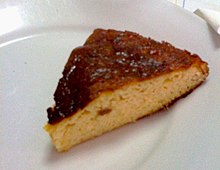You can help expand this article with text translated from the corresponding article in Italian. (October 2024) Click for important translation instructions.
|
 | |
| Type | Savoury |
|---|---|
| Place of origin | Italy |
| Region or state | Basilicata |
| Main ingredients | Eggs, horseradish, potatoes, pecorino, extra virgin olive oil |
Rafanata is an egg-based dish from the Basilicata region of Italy. It is a type of baked frittata made with eggs, horseradish, potatoes, pecorino cheese, and extra virgin olive oil. Rafanata is typical of the Carnival and winter periods.
It is featured in Jamie Oliver's book Jamie Cooks Italy. With a ministerial decree of 25 February 2022, rafanata entered the list of traditional Lucanian agri-food products (PAT).
Etymology
| This section does not cite any sources. Please help improve this section by adding citations to reliable sources. Unsourced material may be challenged and removed. (October 2024) (Learn how and when to remove this message) |
The name comes from rafano, the main ingredient of the dish, which means 'horseradish' in Italian.
History
A dish of peasant origin, it takes its name from horseradish, the rhizome of the plant Armoracia rusticana, a root with a strongly balsamic and spicy taste, probably introduced by the Normans in Basilicata around the 11th century. Horseradish is an essential ingredient of traditional Lucanian cuisine; it often appeared on the tables of farmers and shepherds, being inexpensive, rich in health properties, and a good source of vitamins. Therefore, horseradish is also known in Basilicata as u tartuf' d'i povr' òmm, meaning 'the truffle of the poor'.
Rafanata is traditionally a dish linked to the Carnival festivities, prepared from the feast of Saint Anthony (January 17) until Shrove Tuesday.
See also
References
- Oretta Zanini De Vita, Encyclopedia of Pasta, University of California Press, 2009, p. 122.
- "Jamie Oliver presents Italy in his latest book". idealista.it. 11 December 2018. Retrieved 2 October 2020.
- "Gazzetta Ufficiale, Supplemento ordinario alla "Gazzetta Ufficiale" n. 67 del 21 marzo 2022 – Serie generale, su gazzettaufficiale.it. URL consultato il 27 marzo 2022".
- "La rafanata, la specialità del carnevale in Basilicata". AccetturaOnline.it (in Italian). 2022-03-01. Retrieved 2022-06-08.
- "Rafanata". CuoreBasilicata.it (in Italian). Retrieved 2022-06-08.
- "La Rafanata". Sapori Lucani (in Italian). 2015-03-29. Retrieved 2022-06-08.
This Italian cuisine–related article is a stub. You can help Misplaced Pages by expanding it. |